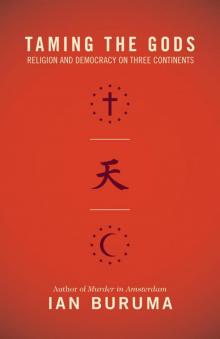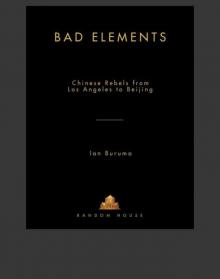- Home
- Ian Buruma
A Japanese Mirror Page 2
A Japanese Mirror Read online
Page 2
Apart from having a mother-fixation, Susanoo was a roughneck. After arriving in his sister’s domain, he smashed the divisions in the rice-fields; he relieved himself in a most unseemly manner during sacred rites; but his worst prank of all was to fling a flayed colt into the hall where the Sun Goddess and her entourage were busy weaving sacred garments. This so distressed one of the weaving maidens that she accidentally pricked her genitals and died.2
Amaterasu was a patient goddess and she loved her brother dearly. At first she put up with his behaviour, making excuses for him and indulging him, hoping that would make him stop. But now he had gone too far. In a huff she retired into a dark cave near Ise (which is now a popular tourist spot). As a result the world was plunged into complete darkness.
The gods decided to hold a meeting. In their very Japanese attempt to reach consensus, ‘the voices of the myriad deities were like swarming flies in the fifth moon … ’3 Several attempts were made to lure the goddess from her cave. She would not budge. Finally a tub was placed upside down in front of the cave and Ama no Uzume, the Dread Female of Heaven, climbed on top of it. In the style of an ancient shamaness, she went into a trance, and began to stamp her feet, slowly at first, but progressively faster, rolling her eyes and wildly waving her spear. She went into an erotic frenzy, which, cheered on by the other deities, reached its shuddering climax when she revealed her breasts and then ‘pushed her skirt-string down to her private parts’.4 With all eyes on her sacred genitals, the gods burst out laughing so loudly that the whole universe could hear them.
Amaterasu, who could not bear other people having fun without her, put her head out of the cave to see what was so funny. Immediately a mirror was pushed in front of her and the Dread Female of Heaven cried out that a new goddess had been found. Amaterasu completely lost her composure and frantically reached out to grasp her reflected image. This gave the Strong-handed Male a chance to grab hold of her and he pulled her out of her hiding place. The world was light again.
Culture of any kind is always influenced by many fads and fashions. Japanese culture has been worked on by history, both native and foreign, by Buddhism, Confucianism, and even at times by Christianity. But underneath the changing surface it has never quite let go of its oldest native roots which are connected to the Shinto cult. By this I do not mean the nationalistic State Shinto concocted by politicians in the late nineteenth century when they were pushing for a strong national identity, but the whole range of sensual nature worship, folk beliefs, ancient deities and rituals. It is the creed of a nation of born farmers, which Japan in many ways still is.
The word Shinto was first coined in the seventh century to distinguish it from Buddhism, called Butsudo. It means Way of the Gods, but it can hardly be called a religion, for there is almost no trace in it of abstract speculation, neither is there much awareness of, or even interest in, another world outside our own. Heaven in the minds of the ancient Japanese was a cosy sort of place full of industrious villagers tending rice-fields.5 There is no evidence of a system of ethics or statecraft, such as we see in China. The earliest myths are, in fact, typically Japanese dramas revolving around human relationships, liberally spiced with sex.
Shinto has many rituals, but no dogma. A person is Shinto in the same way that he is born Japanese.6 It is a collection of myths and ceremonies that give form to a way of life. It is a celebration, not a belief. There is no such thing as a Shintoist, for there is no Shintoism.
Women play a somewhat ambivalent, though significant part in Shinto. Virgins still serve in the holy shrines. And one of the most celebrated figures in Japanese life from ancient times to this day is the mother, hence perhaps the importance of the Sun Goddess, Amaterasu. In patriarchal societies the sun tends to be masculine. In Bengal, for instance, there is a yearly celebration of the marriage between the earth goddess and the sun god.7 As in the Japanese creation myth, the sun rising from the sea is a symbol of the life force in India, but it is associated with Shiva, a male god. In Shinto, which bears traces of a matriarchal culture, it is the other way round: earth is ruled by a male, the spear-carrying Okuninushi. But the source of life is water and the sun rising from it, the symbol of Japan, is female. So too, is the symbolism of fire. In Japan Izanami gives birth to fire and dies as a result.8 In Greece, which is a patriarchal society, the myth tells of a male hero, Prometheus, who steals fire from the gods and is severely punished for it.
Worship of nature obviously includes sex. Like most Japanese, the gods felt no guilt about sex as such. Once the wagtail showed the way Izanami and Izanagi could not stop. Sex is an essential, indeed central part of nature. There is no question of sin. The brother and sister gods were not the only ones in the Japanese pantheon to so enjoy themselves. The Master of the Land (Okuninushi) had numerous lovers in the world he pacified and the only time he ran into trouble was when he refused to go to bed with his lover’s ugly sister. For this breach of good manners, the Japanese emperors – his descendants – were doomed to be mortal.
It is often said that one can get away with almost anything in Japan as long as one is not caught and thus socially shamed. In other words, hedonism is held in check by social taboos. This is putting it rather simply, but let us compare Izanagi and Izanami with Adam and Eve. The latter were thrown out of the Garden of Eden because Eve took a bite from the apple. They were made conscious of good and evil and only thus was it possible to sin.
Japan has no such myth. Izanagi and Izanami were not directly punished for anything they did. They were certainly not removed from any Garden of Eden. Their crisis came when Izanami was seen by her husband in a state of pollution. The disaster concerned her shame rather than anything she consciously did. Although the gods enjoyed sex with impunity, they were terrified of pollution, especially the pollution of death. Izanagi, seeing the putrid body of his sister, barely escaped death himself. One could perhaps say that pollution is the Japanese version of original sin. One must add that women in Shinto, as in many religions, are considered to be more polluted than men, because blood is a form of pollution. In some parts of Japan women used to be segregated in special huts during menstruation.9
The connection between sex and death is certainly not typically Japanese. Georges Bataille, among others, has written eloquently about this concept.10 But although sex as such is not a sin in Japanese thought, there does seem to be a strong fear of the destructive forces sexual passion can unleash, especially in women. (Needless to say, this too is not uniquely Japanese, as one can see in the work of many Catholic artists.)
Jealousy in particular is one such force the Japanese fear. This explains their deeply ambivalent attitude to women. They worship them, especially as mothers, but also fear them as corrupters of purity. Izanami is the creator of life as well as the personification of death and pollution. Her jealousy further prompted her to vow to strangle a thousand people a day. She had no reason to be jealous of another woman, however, for, as far as we know, there was not one in Izanagi’s life. But she hated losing her marital status. And social status, however hard it may be to be bullied by possessive mothers-in-law or neglected by unfaithful husbands, is something most Japanese women cannot do without. Any threat to take it away from them can unleash jealousy of the most violent kind and there is sufficient evidence that men live in morbid fear of it. It is still customary for brides to wear a white hood at their wedding. It looks like a loosely wrapped turban made out of a bed-sheet and it is called a tsunakakushi, a ‘concealer of horns’, the horns namely of jealousy.11
In ‘The Tale of Genji’, written at the beginning of the eleventh century, a Buddhist monk tries to dissuade a mother from letting her daughter have an affair with a married man. He argues that:
Women are born with a heavy load of guilt. As a retribution of the evil passions in their nature they are condemned to flounder about in the darkness of the long night. If your daughter incurs the jealousy of this man’s wife, she will be shackled with fetters from which she can never f
ree herself in this life or the next.12
In The Life of an Amorous Woman, a seventeenth-century novel about a fallen lady, Ihara Saikaku describes how a group of upper-class women gather in a so-called ‘jealousy meeting’ (rinki-ko) to complain about their philandering husbands.13 One after the other, the women, beside themselves with rage, come forward to vent their pent-up emotions by thrashing an effigy of a woman, symbol of all the wicked ladies who led their men astray. Typically it is always the other woman, and not the husband himself, who has to bear the brunt of jealousy.
The most fearsome jealous wives are vengeful spirits who are finishing a job they had left undone when they were still alive. Old plays and folk tales are full of ghosts and spirits of betrayed wives tormenting husbands and rivals, usually ending in cruel and violent death. These horror stories are still performed in theatres and cinemas, traditionally during the clammy summer months, when people are in need of something to chill them.
Like earthquakes and other natural calamities common in the Japanese isles, jealousy, pollution and death simply happen. They will always be with us. But they do not occur because of a sinful act. The concept of sin was, and still is, alien to Japanese thought. The Japanese gods (kami) are like most people, neither wholly good, nor completely bad. There is no Satan in Japan.
One could argue perhaps that Susanoo, the Sun Goddess’s brother, is ‘bad’, but certainly not in any metaphysical or absolute sense. He is the Wind God: his badness just blows. His worst crime, serious enough in Japanese society, is his erratic, selfish and rudely destructive behaviour. He is an unruly adolescent indulging in what is called mewaku kakeru (to cause bother) – a verb, incidentally, often used by the Japanese to describe their behaviour in Asia during the war. Their violence too was like the wind; that it often blew like a hurricane wasn’t their fault: it just happened.
Susanoo’s punishment is a common one in traditional society: he is banished, compelled to be a drifter. This is an unpleasant fate, but it makes him a rather typical Japanese hero.14 The violent man breaking the social rules is not always condemned in Japan – as a fantasy, that is. Social rules, rather than an abstract system of morals, control Japanese behaviour. But they are so pervasive that it takes a hero to break them. The only way for him to do so is to be outside society, for in the end, the community is always stronger than the individual.
So in their hero worship the Japanese often have it both ways: the security of a closed social system is preserved, but the heroic outsider lets people taste vicariously the forbidden fruit of extreme individualism. Also the impetuous violence of the unruly hero (burai) and his contempt for the rules of society are sometimes seen as forms of sincerity, of pure nature reasserting itself against man-made rules. Finally, the hero resembles nothing so much as an angry child ranting and raving against uncomprehending adults. Thus, far from being a model of evil, the screaming Wind-God is regarded with a certain affection. His badness is not evil, but simply a part of human nature which civilized people can learn to suppress, as indeed Susanoo himself manages to do after getting most respectably married to the Rice-Princess. With her he settles down to a life of the blandest domesticity.
Amaterasu’s reaction to her fierce brother’s abominations is quite compliant at first. She indulges his whims like a doting mother blind to her boy’s faults: after all, he cannot help the way he is. When things finally go too far, it is she who retreats into the cave, not he. One could conclude, as many casual observers of the Japanese scene do, that men rule their women like spoiled despots. This is a superficial view, however, for at a very basic level (and Shinto is fairly basic) women have an awesome power over their men.
In myths the magic of the vagina is more potent than that of the phallus. There is a phallic god called Sarutahiko, blessed with a long, red nose. This walking penis, symbol of the force of life, is so powerful that demons flee at the sight of him. And yet it is said that when the Dread Female of Heaven pushed down her skirt-string even he lost his strength and wilted like a dead flower.15
The exhibition of the Dread Female’s private parts, which so greatly amused the gods, probably had a magical significance. Early sculptures have been excavated showing female divinities exposing their genitals.16 This image was later transposed to Kannon, the Buddhist Goddess of Mercy.17 ‘Going to see Kannon’ is still a popular slang expression for visiting a striptease parlour. And only in Japan would an internationally known film-star insist on kissing his mother’s genitals publicly at her funeral. This was widely reported in the press, with respect rather than shock or even much surprise.18
There are many legends about the magical qualities of the female organ. To mention just one: two women were chased by a group of demons. They tried to get away in a rowing boat, but still the demons kept up their pursuit. Then, just at the critical moment, a goddess appeared, advising the women to reveal their private parts. She proceeded to do so herself. The women, a little bashfully at first, followed her example and the demons gave up the chase, roaring with laughter.19
This laughter among gods, demons and men is not just a sign of good fun. It may be that too, but it is also a liberation from fear. Laughter in Japan, like anywhere else, is often a mechanism for breaking the tension, in the same way that people laugh at violence in the cinema. The female sex in all its impenetrable mystery is feared as much as it is worshipped. Or, more accurately, it is worshipped because it is feared. As in many cultures, there are legends about this fearsome side of female power: about clam-like vaginas that snip off male genitals like steel traps.
Buddhism helped to strengthen these fears. There is no room for women in Buddhist Nirvana. They have to be reborn as men first. According to a well-known sutra ‘woman is an emissary from Hell; she will destroy the germ of the Buddha. Her appearance seems holy, but she has the heart of a demon.’20
The female body is a source of pollution. Murasaki Shikibu, the authoress of ‘The Tale of Genji’, certainly not a prudish work, described the naked body as ‘unforgettably horrible’. None the less nudity in Japan is a strange and paradoxical thing, for people do take baths in public, in certain rural areas even mixed baths. Yet a large number of schoolboys and old ladies are hired as part-time workers at Japanese customs offices to delete with ink and razor any pubic hair that might be showing in imported publications. But striptease of the crudest kind is allowed to take place in Japan unimpeded. Morality is very much a matter of time and place and nothing is absolute.
The fascination in religious ceremonies, myths and the popular arts for the sexual organs (the grotesque stylization of male and female genitals in erotic woodblock prints, for example) is as much a celebration of life and fertility as a form of exorcism. It is as if one can ward off the dangers inherent in the mysteries of nature by laughter or stylization, by turning raw nature into man-made symbols. In various parts of Japan there are literally ‘laughing festivals’, where people laugh at local shrines to please the gods. Inside these shrines one often finds images of female and male sexual organs.
Though absolute Evil seems to be absent from Japanese thought, every form of pollution, including wounds, sores, blood, death and even simple uncleanliness is to be feared. The traditional antidote to the polluting forces of nature is purification. Izanagi’s ablutions in the Tachibana river after his return from the Underworld are a typical example. Naturally, purification in one form or another exists in religious ceremonies everywhere, but in few cultures is it taken as seriously and is it as much a part of daily life as in Japan.
One finds evidence of it in the most disparate places: in the wrestling ring, for example, which sumo-wrestlers sprinkle with purifying salt before every bout. Little heaps of salt can also be seen in front of homes, on the doorsteps of bars, massage parlours or any other place where pleasure is bought and sold. The Japanese feeling for purity manifests itself in other, less obvious ways: the ubiquitous habit of wearing white gloves by people performing public functions, for instance. Politicia
ns making speeches wear them, taxi drivers are never without them, policemen and even elevator operators in department stores wear them; everywhere one goes in Japan, one sees this ceremonial white on people’s hands.
Bathing is a cult. Keeping clean is so universal a preoccupation that all one smells in packed commuter trains during rush hours in Tokyo is a faint whiff of soap. Most Shinto festivals involve ritual bathing. The first bathhouses, still a social institution in cities, were part of Buddhist temples, dating from the seventh century. But, like many religious habits in Japan – drinking saké is another – bathing soon became a sensual experience enjoyed for its own sake.
The Japanese have the same attitude to bathing as Frenchmen reserve for eating: they do it with a mixture of connoisseurship and physical abandon. A bath can be enjoyed alone, but it is more often taken with many others, keeping up with the latest gossip while scrubbing one’s neighbour’s back. Bathing has become a major gimmick in holiday resorts built around hot springs. One place features a gigantic heart-shaped bath with room for hundreds of romping honeymoon couples; at another resort one can bathe in a solid gold bath in the shape of a large chicken, which costs 1,500 yen (five dollars) a minute to sit in; and there is even a bath that moves up a mountain on tracks so that one can enjoy the view while soaking in the tubs.
But pleasure has its reverse side in Japan. Purification rituals in Shinto are an example of what has been called the stoic hedonism of the Japanese.21 As in many cultures, though few are as extreme, there is a strong belief in Japan that physical suffering and deprivation are purifying experiences. Standing on smouldering bonfires or wading through icy rivers stark naked in mid-winter – to name but two uncomfortable examples – and sensual pleasure, even erotic ecstasy, go hand in hand in the Japanese celebration of the gods.

 A Japanese Mirror
A Japanese Mirror Taming the Gods
Taming the Gods The China Lover
The China Lover A Tokyo Romance
A Tokyo Romance Theater of Cruelty
Theater of Cruelty Year Zero
Year Zero The Wages of Guilt
The Wages of Guilt Murder in Amsterdam
Murder in Amsterdam Bad Elements
Bad Elements Their Promised Land
Their Promised Land Occidentalism
Occidentalism Anglomania
Anglomania Inventing Japan: 1853-1964 (Modern Library Chronicles)
Inventing Japan: 1853-1964 (Modern Library Chronicles) The Missionary and the Libertine
The Missionary and the Libertine